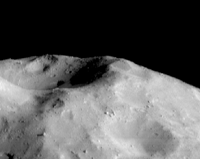SUMMARY

Findings:
-
There should be ~950 NEOs
with H<18 and
~850 with diameter larger than 1 kilometre, with a<7.4
AU
-
The current observational completeness of this population
is slightly smaller than 50%
-
With the current surveys, the H<18 objects will
reach 90% observational completeness in ~60 years
-
Objects with H<18 NEO should collide with the
Earth (on average) once every 500,000 y. The energy produced by these impacts
is equivalent to 46,000 megaton TNT
-
Collisions with energies larger than 1,000 megaton are
caused by NEOs with H<20.5; they stike the Earth (on average)
every 63,000 years
-
The efficiency of a NEO survey strongly depends on the
heliocentric distance of the observatory. A space survey onboard a spacecraft
placed at Mercury's or Venus's heliocentric distance would offer a tremendous
advantage
with respect to a survey conducted from the ground or onboard a geocentric
satellite
Recommendations:
-
Governments should not be satisfied with the current facilities
dedicated to NEO searches. Resources should be allocated to increase both
the limiting magnitude and the sky coverage, in order to improve the detection
efficiency.
-
The Spaceguard
goal should be extended to include the NEOs with H<20.5 in
order to protect the society from these frequent and dangerous impactors
-
Space agencies should seriously consider the possibility
of developing a dedicated space-based NEO survey, onboard a spacecraft
placed in the inner solar system
NEXT PAGE
PREVIOUS PAGE
FIRST PAGE

